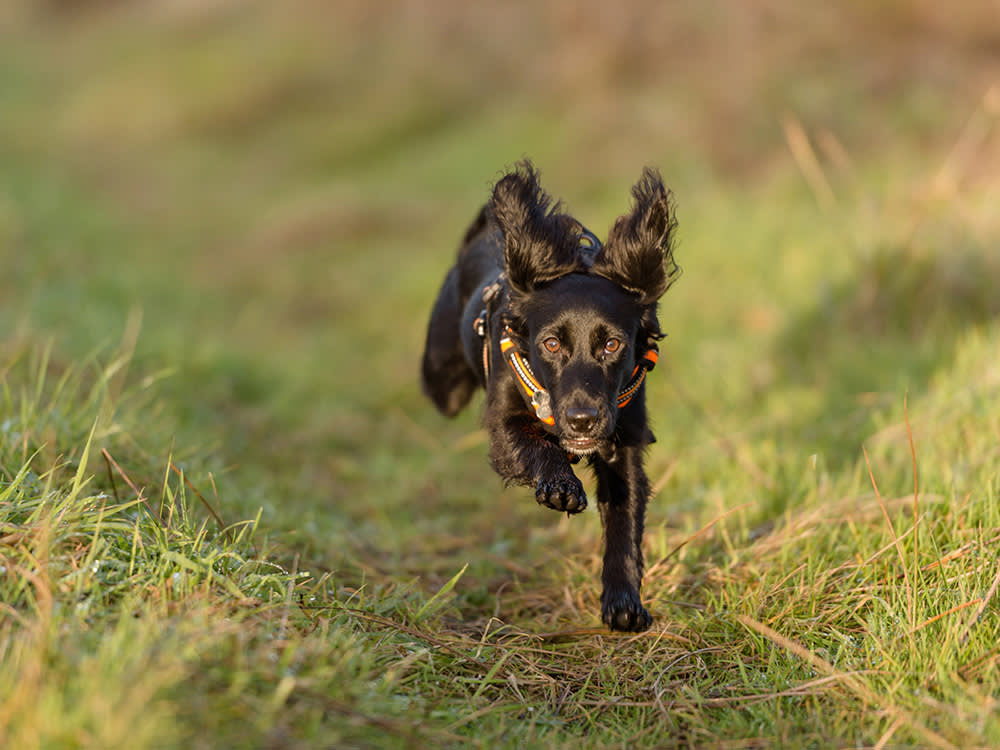Prey Drive in Dogs: Fact or Fiction?
Is the term ‘prey drive’ correct terminology or meaningless jargon?

share article
If you have an urge to create discord and angst, here’s one way to do it: go to a dog behaviour conference or seminar and boldly state, “I think we should discuss the meaning of the term ‘prey drive,’ and decide whether or not we should continue to use it.” Then, make a dash for the exit before it gets ugly.
What is prey drive?
The term ‘prey drive’ refers to a dog’s eagerness, or desire, related to chasing and capturing prey. But, the terminology employed to describe canine behaviour is messy, perhaps in part because dog behaviour encompasses a number of disciplines, among them ethology, evolution, physiology, neurobiology, sociology, psychology, learning theory and animal husbandry.
The term is often used by people whose dogs participate in canine sports, such as agility or flyball, as well as by those whose dogs work in search and rescue or law enforcement. Additionally, it has become increasingly popular when discussing dogs with various behavioural issues, typically issues related to chasing (cars, squirrels, runners, bikes, children) and the resulting difficulty in teaching them to come or to pay attention in general around any of these distractions.
Sometimes ‘prey drive’ is used in a positive sense, as in, ‘They’re excited about working because they have a high prey drive. I love their enthusiasm and motivation, and the prey drive gives them such great endurance, too.’ It can also be used in a negative way, as in, ‘I can never let them off lead in areas that aren’t fenced in. They have such high prey drive that they’ll chase anything. I can’t trust them to come back or stay out of trouble.’ So, though prey drive is a common concept in the dog world, many people dislike it.
Are dogs driven to chase?
If you ask an ethologist (someone who studies the behaviour of animals in their natural environments) who isn't involved in the ‘dog world’ what they think of the term ‘prey drive’, they will look at you quizzically and then criticise it on the grounds that it’s nonsensical.
To ethologists, the word ‘drive’ refers to an unknown and variable internal state that explains why an animal’s response to a stimulus is not identical every time the animal is exposed to it. For example, at times, a dog may charge after a tennis ball with gleaming eyes and an over-the-top bouncy enthusiasm, while at other times, that same dog may lazily lope after the ball or even ignore it, though the stimulus (the thrown ball) is the same. What’s different is the dog’s interest in chasing it.
‘Drive’ is the term used to explain that difference, which ethologists consider to be a difference in internal states, perhaps based on neurological or physiological variables over time.
Fluctuation in an animal’s drive doesn’t just affect predatory behaviour. It also influences how eager a dog is to eat, drink and engage in sexual behaviour, or any other type of behaviour for that matter. Yet we don’t talk about food drive, water drive or potential-mating-partner drive. We say that a dog is hungry or food-motivated; that the dog is thirsty; or, in the case of females, that she is sexually receptive. To be fair, the term ‘sex drive’ is used to describe the state of having an interest in mating – referring typically (but not always) to males – but we don’t say female drive or male drive.
Even in the way that many people use it, prey drive lacks precision. Does it mean a drive to run, to chase, to catch something, to bite it, to kill it, or any combination of these? Is it all related to predatory behaviour, and if so, why is the term ‘prey drive’ used, rather than ‘predatory drive’?
Prey drive, aggression and impulse control
Words and phrases that express precise concepts are indispensable for communication, and the more specific we can be, the better. However, the inexactness of language can make it a challenge to convey precise meanings. For example, because English is short on words that describe emotional nuance, people say things such as, ‘Do you like him or do you like him?’
Some people feel that the word ‘drive’ doesn’t actually explain an animal’s behaviour. In one sense, it’s an oversimplification to say that an animal is behaving a certain way because of an internal state or a change in that internal state. We know that an animal’s motivation changes over time and that different members of the same species behave differently in the presence of identical stimuli, but we don’t often know why. So, the term is more descriptive and less explanatory than it purports to be. A term such as ‘prey drive’ is essentially shorthand to describe what we don’t understand, since we don’t have complete knowledge of dogs’ internal states and their effect on behaviour.
Another problem with prey drive is that it is often used in an attempt to explain a dog’s unwanted behaviour toward other dogs and even people, neither of which are normally objects of canine predatory focus. We’ve all heard people dismiss a dog’s inappropriate, undesirable and sometimes even aggressive behaviour with the comment that the dog has a high prey drive. It sounds so much nicer than saying that the dog has little impulse controlopens in a new tab, a far-from-ideal temperament, or insufficient training.
A more suitable term?
Criticisms of the phrase are a predictable result of the fact that, often, when terms are appropriated from other fields, they are used in a slightly different way. The current meaning of terms in our field may not match their original use, which can lead to confusion, and the assumption the term is being used incorrectly.
It’s wise to acknowledge that terms have to be considered in context. Would it be better if no such confusion ever arose, and multiple meanings didn’t exist? Sure. But the reality is that languages change, as do fields of study and their associated terminology.
Cultures vary in the way they accept and integrate shifting meanings in the language used to describe the world around them. On one extreme, the French are known to take pride in the stability of their language, and place great importance on maintaining its correct usage and resisting change, particularly Anglicisms. At the other extreme is surfer culture, with its enthusiastic proliferation of new words and phrases such as ‘tubular’, ‘hang 10,’ ‘in the soup’ and ‘goofy-footed’.
Finding a balance
While some folks enjoy referring to ‘prey drive’, ‘predatory drift’ or ‘reactivityopens in a new tab’ (the term ‘aggression’ used to suffice), others would prefer to hear that a dog is enthusiastic about agility or flyball, or that the dog is motivated to run the course, take the jumps or retrieve a ball. What’s important is that we understand one another.
Just know that when most people talk about prey drive in dogs, they are referring to the enthusiasm and strong motivation that makes dogs sharp on the course, eager to participate, and ready to give their all in competition or in play.

Karen B. London, PhD, CAAB, CPDT-KA
Karen B. London, Ph.D., is a Certified Applied Animal Behaviorist and Certified Professional Dog Trainer who specializes in working with dogs with serious behavioral issues, including aggression, and has also trained other animals including cats, birds, snakes, and insects. She writes the animal column for the Arizona Daily Sun and is an Adjunct Professor in the Department of Biological Sciences at Northern Arizona University. She is the author of six books about training and behavior, including her most recent, Treat Everyone Like a Dog: How a Dog Trainer’s World View Can Improve Your Lifeopens in a new tab.
Related articles
![Greyhound dog lying on top of couch looking out of a window]() opens in a new tab
opens in a new tab6 Calming Products That Help My Dog’s Anxiety
Compression vests, interactive toys and pheromone sprays will be game-changers for nervous pups
![]() opens in a new tab
opens in a new tabAll Aboard! How To Take Your Dog On A Train Journey
Heading home for Christmas? Here’s how to help your pup (and you) survive that stressful train journey
![Woman walking her dog in a park]() opens in a new tab
opens in a new tabDog Walking 101: How Often You Should Walk Your Dog
Your dog may need more exercise than you think, according to three pet experts
![Shiba inu dog sleeping in bed]() opens in a new tab
opens in a new tabMy Dog Sleeps All Day – Is that Normal?
Dogs need more sleep than humans. Here’s how much is healthy






